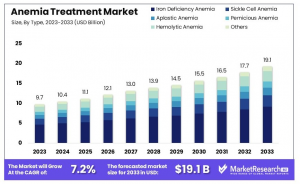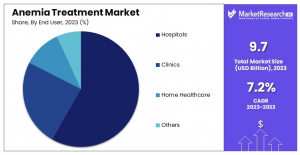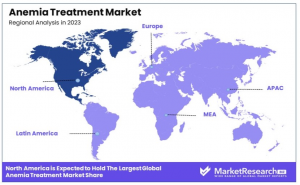Anemia Treatment Market Poised for Strong Growth, Expected to Hit USD 19.1 Billion by 2033
Global Anemia Treatment Market size is expected to be worth around USD 19.1 Billion by 2033, from USD 9.7 Billion in 2023, growing at a CAGR of 7.2%
Oral Iron Therapy dominates with 35% due to its ease of use and effectiveness in treating iron deficiency anemia.”
NEW YORK, NY, UNITED STATES, February 20, 2025 /EINPresswire.com/ -- Overview— Tajammul Pangarkar
Global Anemia Treatment Market size is expected to be worth around USD 19.1 Billion by 2033, from USD 9.7 Billion in 2023, growing at a CAGR of 7.2% during the forecast period from 2024 to 2033.
Anemia is a global health concern affecting over 1.6 billion people, with iron deficiency being the most common cause. This condition leads to fatigue, weakness, and impaired cognitive function, significantly impacting quality of life. Recent advancements in anemia treatment are providing more effective and accessible solutions for patients worldwide.
Traditional treatments, including iron supplements, dietary modifications, and blood transfusions, remain widely used. However, new therapies such as intravenous iron formulations, erythropoiesis-stimulating agents (ESAs), and gene therapies are revolutionizing anemia care. These innovative approaches help restore hemoglobin levels faster, reducing the need for frequent hospital visits.
The pharmaceutical industry is actively developing next-generation iron therapies that improve absorption and reduce gastrointestinal side effects. Additionally, AI-driven diagnostics enable early anemia detection, ensuring timely intervention. Global health organizations are also emphasizing public health initiatives to combat anemia through fortified foods and better prenatal care.
With the growing demand for effective anemia treatments, healthcare providers and researchers continue to focus on personalized medicine and targeted therapies. These advancements promise to enhance patient care, reduce complications, and improve overall health outcomes worldwide.
Click here to get a Sample report copy @ https://marketresearch.biz/report/anemia-treatment-market/request-sample/
Key Takeaways
•Market Value: The Anemia Treatment Market was valued at USD 9.7 billion in 2023 and is projected to grow to USD 19.1 billion by 2033, registering a CAGR of 7.2% during the forecast period.
•Type Analysis: Iron Deficiency Anemia remains the leading segment, accounting for 48% of the market, driven by its high prevalence worldwide.
•Therapy Type Analysis: Oral Iron Therapy holds the largest share at 35%, primarily due to its convenience and widespread adoption.
•End User Analysis: Hospitals dominate the market with a 60% share, underscoring their critical role in anemia diagnosis and management.
•Regional Analysis: North America leads with approximately 40% of the market share, supported by advanced healthcare infrastructure and strong R&D investments.
•Analyst Viewpoint: The market is moderately saturated, with intense competition among key players. Growth is expected to be driven by innovative treatment approaches and increasing awareness.
•Growth Opportunities: Companies can capitalize on developing advanced anemia therapies and expanding their presence in emerging markets to maximize growth potential.
Segmentation Analysis
•Type Analysis: Iron Deficiency Anemia dominates with 48% market share, driven by its widespread prevalence. Poor diets and women's health issues, including heavy menstruation and pregnancy-related complications, contribute to its high occurrence. Sickle Cell Anemia is significant in Africa and African American populations due to genetic predisposition, requiring specialized treatment. Aplastic, Pernicious, and Hemolytic Anemia are less common but need specific therapies like immunosuppressants or vitamin B12 injections. The "others" category includes rare anemia types requiring specialized treatment regimens.
•Therapy Type Analysis: Oral Iron Therapy leads with 35% share due to its ease of use, affordability, and effectiveness in treating iron deficiency anemia. Parenteral Iron Therapy is essential for conditions like chronic kidney disease, where oral iron is ineffective. Red Blood Cell Transfusion is critical for severe anemia cases, surgeries, and childbirth. Erythropoiesis-Stimulating Agents (ESAs) are widely used for chronic kidney disease patients. Vitamin B12 and Folic Acid Supplements treat pernicious anemia, while the “others” category includes newer and specialized treatments.
•End User Analysis: Hospitals dominate with 60% market share, offering comprehensive anemia management with advanced diagnostic tools and specialist care. Clinics provide essential chronic anemia management and decentralized care for conditions like sickle cell anemia. Home Healthcare is expanding, enabling routine anemia treatment for elderly and remote patients through oral and injectable therapies. The "others" category, including long-term care facilities and community health centers, supports underserved populations with tailored anemia treatments and ongoing care.
Market Segments
Type
•Iron Deficiency Anemia
•Sickle Cell Anemia
•Aplastic Anemia
•Pernicious Anemia
•Hemolytic Anemia
•Others
Therapy Type
•Oral Iron Therapy
•Parenteral Iron Therapy
•Red Blood Cell Transfusion
•Erythropoiesis-Stimulating Agents (ESAs)
•Vitamin B12 and Folic Acid Supplements
•Others
End User
•Hospitals
•Clinics
•Home Healthcare
•Others
To Purchase this Premium Report @ https://marketresearch.biz/purchase-report/?report_id=48347
Market Dynamics
••Driver: The anemia treatment market is primarily driven by the high global prevalence of anemia, especially among children and women in low- and middle-income countries. Factors such as nutritional deficiencies, particularly iron deficiency, contribute significantly to anemia cases. Efforts to combat this include mandatory food fortification programs; for instance, Ghana has implemented standards for fortifying wheat flour with iron and other micronutrients to address widespread deficiencies. These public health initiatives aim to reduce anemia rates and, in turn, drive the demand for effective anemia treatments.
••Trend: A notable trend in anemia treatment is the shift towards more cautious and individualized use of erythropoiesis-stimulating agents (ESAs). While ESAs can effectively increase hemoglobin levels, concerns about their long-term safety, particularly in patients with chronic kidney disease, have prompted healthcare providers to adopt more judicious prescribing practices. Additionally, there is a focus on simplifying and economizing ESA treatments to reduce healthcare costs and improve patient compliance. This trend reflects a broader movement towards personalized medicine and cost-effective healthcare solutions.
••Restraint: The anemia treatment market faces challenges due to recurrent shortages of essential medications, such as lead chelators. Between 2001 and 2022, multiple shortages of key chelating agents were reported, with some lasting several months. These shortages can disrupt treatment protocols, leading to suboptimal patient outcomes and increased healthcare burdens. The reliance on a limited number of manufacturers for these drugs exacerbates the vulnerability of the supply chain, highlighting the need for improved production strategies and supply chain resilience.
••Opportunity: There is a significant opportunity in developing and implementing comprehensive food fortification programs to prevent anemia, particularly in regions with high prevalence rates. For example, fortifying staple foods like wheat flour with iron and other essential micronutrients has been shown to reduce anemia prevalence. Countries such as Ghana have established mandatory fortification standards, leading to improved nutritional status among their populations. Expanding such programs globally, especially in low-income countries, can serve as a preventive strategy against anemia, reducing the need for medical treatments and associated healthcare costs.
Market Key Players
•Amgen Inc.
•Pfizer Inc.
•GlaxoSmithKline plc
•Novartis AG
•Hoffmann-La Roche Ltd
•Johnson & Johnson
•Sanofi S.A.
•Vifor Pharma
•Daiichi Sankyo Company, Limited
•Bayer AG
•Akebia Therapeutics
•Rockwell Medical, Inc.
•FibroGen, Inc.
•Pieris Pharmaceuticals
•Biocon Limited
Regional Analysis
North America holds a 40% share in the global anemia treatment market, driven by its advanced healthcare infrastructure and the high prevalence of chronic diseases like kidney disease and diabetes, which frequently lead to anemia. The region benefits from strong pharmaceutical research and development, resulting in continuous innovations in anemia treatments. Additionally, high healthcare spending and comprehensive insurance coverage ensure widespread access to advanced therapies, further strengthening market dominance.
A high level of awareness regarding anemia symptoms and risks contributes to early diagnosis and timely treatment, improving patient outcomes. The region’s robust regulatory framework facilitates the rapid approval and adoption of new therapies, boosting market expansion. Moreover, collaborations between public health agencies and pharmaceutical companies enhance treatment effectiveness, driving further growth in North America’s anemia treatment market.
Emerging Trends in Anemia Treatment
•Advanced Therapies for Rare Anemias: Recent developments have introduced new treatments for uncommon types of anemia, such as hemoglobinopathies and congenital hemolytic anemias. These therapies aim to reduce the need for blood transfusions and manage iron overload, improving patient outcomes.
•Non-Invasive Diagnostic Tools: Innovations in point-of-care technologies now allow for non-invasive or minimally invasive anemia detection. These advancements enable quicker and more accurate diagnoses, facilitating timely treatment and better patient care.
•Personalized Medicine Approaches: There's a growing emphasis on tailoring anemia treatments to individual patient needs. This includes careful use of erythropoiesis-stimulating agents (ESAs) and iron supplements, considering each patient's specific condition to enhance effectiveness and safety.
•Exploration of Androgen Therapy: Research into the use of androgens, a type of hormone, has shown potential in stimulating red blood cell production. This approach offers an alternative treatment avenue, especially for patients who may not respond well to traditional therapies.
•Global Health Initiatives: International efforts are focusing on addressing anemia through public health strategies, such as food fortification and improved nutritional programs. These initiatives aim to reduce the incidence of anemia, particularly in regions where it is most prevalent.
Use Cases in Anemia Treatment
•Chronic Kidney Disease (CKD) Patients: Anemia is common among CKD patients due to reduced erythropoietin production by the kidneys. Treatments often involve ESAs and iron supplements to maintain hemoglobin levels. Studies have shown that appropriate management can decrease the need for blood transfusions and improve quality of life.
•Pregnant Women: Anemia during pregnancy can lead to complications like preterm birth and low birth weight. Iron supplementation, either oral or intravenous, has been effective in increasing hemoglobin levels. Meta-analyses indicate that intravenous iron can improve hemoglobin by approximately 7 to 8 g/L compared to oral iron, offering a viable option for those who cannot tolerate oral supplements.
•Surgical Patients with Preoperative Anemia: Around 30% of adults scheduled for non-cardiac surgery have anemia. Preoperative treatment with a combination of iron and erythropoietin has been shown to reduce the need for blood transfusions during and after surgery, enhancing recovery outcomes.
•Patients with Rare Anemias: Individuals with uncommon forms of anemia, such as autoimmune hemolytic anemia or paroxysmal nocturnal hemoglobinuria, often require specialized treatments. Emerging therapies have demonstrated success in reducing transfusion dependence and managing disease symptoms, leading to improved patient quality of life.
•Elderly Population: The prevalence of anemia increases with age, often due to nutritional deficiencies or chronic diseases. Treatment typically involves addressing the underlying cause and supplementing deficiencies. Studies have found that treating iron deficiency in the elderly can reduce blood transfusion requirements and increase hemoglobin levels, thereby improving overall health outcomes.
Lawrence John
Prudour
+91 91308 55334
Lawrence@prudour.com
Legal Disclaimer:
EIN Presswire provides this news content "as is" without warranty of any kind. We do not accept any responsibility or liability for the accuracy, content, images, videos, licenses, completeness, legality, or reliability of the information contained in this article. If you have any complaints or copyright issues related to this article, kindly contact the author above.



